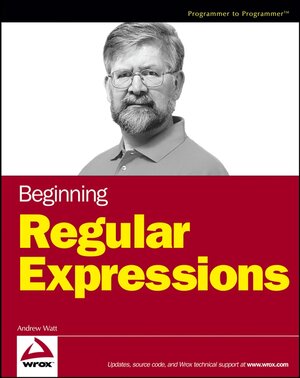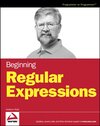
×
![Buchcover ISBN 9780764595745]()
Beginning Regular Expressions
von Andrew WattThis book introduces the various parts of the construction of aregular expression pattern, explains what they mean, and walks youthrough working examples showing how they work and why they do whatthey do. By working through the examples, you will build yourunderstanding of how to make regular expressions do what you wantthem to do and avoid creating regular expressions that don'tmeet your intentions.
Beginning chapters introduce regular expressions and show you amethod you can use to break down a text manipulation problem intocomponent parts so that you can make an intelligent choice aboutconstructing a regular expression pattern that matches what youwant it to match and avoids matching unwanted text.
To solve more complex problems, you should set out a problemdefinition and progressively refine it to express it in English ina way that corresponds to a regular expression pattern that doeswhat you want it to do.
The second part of the book devotes a chapter to each of severaltechnologies available on the Windows platform. You are shown howto use each tool or language with regular expressions (for example, how to do a lookahead in Perl or create a named variable inC#).
Regular expressions can be useful in applications such as MicrosoftWord, OpenOffice. org Writer, Microsoft Excel, and Microsoft Access. A chapter is devoted to each.
In addition, tools such as the little-known Windows findstr utilityand the commercial PowerGrep tool each have a chapter showing howthey can be used to solve text manipulation tasks that spanmultiple files.
The use of regular expressions in the MySQL and Microsoft SQLServer databases are also demonstrated.
Several programming languages have a chapter describing themetacharacters available for use in those languages together withdemonstrations of how the objects or classes of that language canbe used with regular expressions. The languages covered areVBScript, Javascript, Visual Basic . NET, C#, PHP, Java, andPerl.
XML is used increasingly to store textual data. The W3C XML Schemadefinition language can use regular expressions to automaticallyvalidate data in an XML document. W3C XML Schema has a chapterdemonstrating how regular expressions can be used with thexs: pattern element.
Chapters 1 through 10 describe the component parts of regularexpression patterns and show you what they do and how they can beused with a variety of text manipulation tools and languages. Youshould work through these chapters in order and build up yourunderstanding of regular expressions.
The book then devotes a chapter to each of several textmanipulation tools and programming languages. These chapters assumeknowledge from Chapters 1 through 10, but you can dip into thetool-specific and language-specific chapters in any order youwant.
Beginning chapters introduce regular expressions and show you amethod you can use to break down a text manipulation problem intocomponent parts so that you can make an intelligent choice aboutconstructing a regular expression pattern that matches what youwant it to match and avoids matching unwanted text.
To solve more complex problems, you should set out a problemdefinition and progressively refine it to express it in English ina way that corresponds to a regular expression pattern that doeswhat you want it to do.
The second part of the book devotes a chapter to each of severaltechnologies available on the Windows platform. You are shown howto use each tool or language with regular expressions (for example, how to do a lookahead in Perl or create a named variable inC#).
Regular expressions can be useful in applications such as MicrosoftWord, OpenOffice. org Writer, Microsoft Excel, and Microsoft Access. A chapter is devoted to each.
In addition, tools such as the little-known Windows findstr utilityand the commercial PowerGrep tool each have a chapter showing howthey can be used to solve text manipulation tasks that spanmultiple files.
The use of regular expressions in the MySQL and Microsoft SQLServer databases are also demonstrated.
Several programming languages have a chapter describing themetacharacters available for use in those languages together withdemonstrations of how the objects or classes of that language canbe used with regular expressions. The languages covered areVBScript, Javascript, Visual Basic . NET, C#, PHP, Java, andPerl.
XML is used increasingly to store textual data. The W3C XML Schemadefinition language can use regular expressions to automaticallyvalidate data in an XML document. W3C XML Schema has a chapterdemonstrating how regular expressions can be used with thexs: pattern element.
Chapters 1 through 10 describe the component parts of regularexpression patterns and show you what they do and how they can beused with a variety of text manipulation tools and languages. Youshould work through these chapters in order and build up yourunderstanding of regular expressions.
The book then devotes a chapter to each of several textmanipulation tools and programming languages. These chapters assumeknowledge from Chapters 1 through 10, but you can dip into thetool-specific and language-specific chapters in any order youwant.



